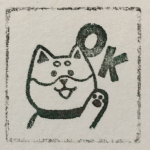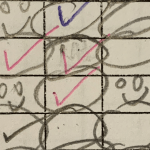 To correct or not to correct? It’s an ongoing discussion among my colleagues both in school and on line. Is it of any use? Do students learn anything from us doing it? What to do?
To correct or not to correct? It’s an ongoing discussion among my colleagues both in school and on line. Is it of any use? Do students learn anything from us doing it? What to do?
In keeping with my attempts to provide more feedback – and ‘dialogue’ with students about their work – I abandoned the ‘teacher correct’ model a couple of years ago. I also looked to this move to help strengthen student accountability for their own work (and their role in their learning).
In my class it goes like this – students generate sentences or chunks depending upon our focus. They hand in (or can submit online). If there are no issues they get the Shiba Inu ‘okay’ stamp. (if you are unfamiliar …this a Japanese breed and I happened upon this set of stamps at a local Japanese store). In my mark book I indicate this with a happy face (yes a happy face). An online submission gets the JPG attached when I return it.
If there are any issues I will indicate things that I want the student to look at again. Sometimes it’s just spelling. Sometimes something is missing. And at other times the structure I am looking for is not used correctly. My feedback for their corrections can be a simple notation (such as ‘sp!’ or ‘missing…’). At other times it’s a reminder..(remember this is one of those that…). Often it leads to a quick discussion one on one as in “Sensei, I’m not sure …” or “Sensei, is this supposed to be…?” Then they resubmit for me to take a look. In my mark book this is indicated with a ‘circle’ (handed in but awaiting correction)  Once it looks fine – the stamp goes on (or admittedly in a rush my scribbled ‘okay’) and I put a check mark in the circle in my book.
Once it looks fine – the stamp goes on (or admittedly in a rush my scribbled ‘okay’) and I put a check mark in the circle in my book.
Now students know that there are no ‘marks’ attached to this beyond completing. They know that they don’t ‘have’ to do this. But they also know that their choice not to do them means that they miss out on growth, on learning and on raising their level of language. Yes there are students who don’t do this and who choose to ignore this input for improving. Sometimes they are then asked to (or required to) come in for mandatory assistance during our school support block. Their lack of engagement in their learning is also noted in a comment when reporting to parents. In the end ‘does this count towards my mark?’ is answered in the quality of the unit assessment and their proficiency level (reflecting accuracy and consistency). I feel that I see stronger more accurate language as a result of this process.
Please note that I am lucky to work with several neuro-diverse students. Their feedback is just as deep as other students’ is but I adjust the ‘correction’ idea to fit their individual strengths (for example ‘recognizing a correct answer’ instead of self-generating one or putting in a part of the answer with me giving the rest.)
I like this idea of a ‘dialogue’ for each student and the discussion it sparks around the language…and I like that they demonstrate an interest in improving their understanding…
Colleen

